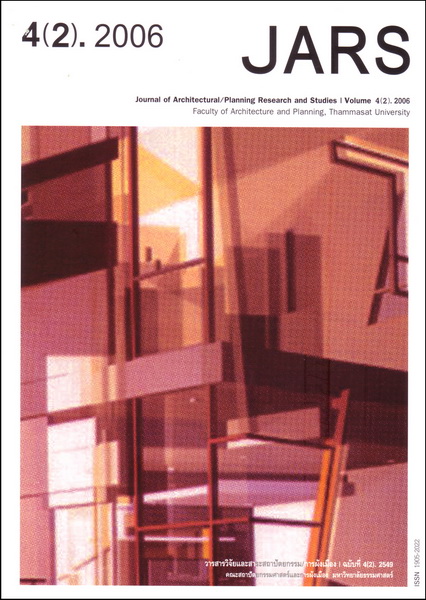Flexible Workplace: Benefits and Concerns in Facilities Management
Main Article Content
Abstract
Change in organization is inevitable. In a workplace, an office worker is relating to an organization
in a new way. The growth of business and economy has highly influenced upon the increasing cost of real
estate. Many companies cannot afford office space rent, which becomes the second highest cost of total
expenses. Furthermore, changes in organizational work pattern, people lifestyle and technological development
also influence upon new expectations of the office’s physical environment. Through reviewing driving forces
and a number of cases, potential benefits and concerns of flexible workplace are identified together with
proposition of critical roles of facilities managers regarding the changing ways of working. This paper aims
to examine the ways of achieving high performance workplace and the implication to facilities management
in the context of flexible workplace.
Downloads
Article Details

This work is licensed under a Creative Commons Attribution-NonCommercial-NoDerivatives 4.0 International License.
All material is licensed under the terms of the Creative Commons Attribution 4.0 International (CC-BY-NC-ND 4.0) License, unless otherwise stated. As such, authors are free to share, copy, and redistribute the material in any medium or format. The authors must give appropriate credit, provide a link to the license, and indicate if changes were made. The authors may do so in any reasonable manner, but not in any way that suggests the licensor endorses you or your use. The authors may not use the material for commercial purposes. If the authors remix, transform, or build upon the material, they may not distribute the modified material, unless permission is obtained from JARS. Final, accepted versions of the paper may be posted on third party repositories, provided appropriate acknowledgement to the original source is clearly noted.
References
Becker, F., & Steele, F. (1995). Workplace by design: Mapping the high performance workscape. San Francisco: Jossey-Bass Publishers.
Duffy, F., Laing, A., & Crisp, V. (1993). The responsible workplace: The redesign of work and offices. London: Butlerworth Architecture, DEGW.
Laing, A. (1991). The post-fordist workplace: Issues of time and place. Facilities, 9 (8).
Drucker, P. (1993). Post-capitalist society. New York, NY: Harper Business.
Handy, C. (1989). The age of unreason. London: Business Books.
Eley, J., & Marmot, A. (1995). Understanding offices. London: Penguin Books.
Otto E., Stallworth JR., & Kleiner, B. H. (1996). Recent developments in office design. Facilities, 14 (1/2), 34.
British Council for Offices. (2004). Office futures. Retrieved July 30, 2006, from http://www.bco.org.uk.
Center for Building Performance and Diagnostics. (2006). Intelligent workplace. Retrieved September 3, 2006, from http://www.arc.cmu.edu/cbpd/iw/index.html.
Nutt, B. (2000). Facility management: Risks and opportunities. Oxford: Blackwell Science.
Steiner, J. (2005). The art of space management: Planning flexible workspaces for people. Facilities, 4 (1).
McGookin, S. (1999, March). L-plates for IT students. Financial Times, 1.
Becker, F. (1990). The total workplace. New York, NY: Van Nostrand Reinhold.
White, A. (1995). The future for offices. Flexible working, 1 (1).
Hall, E. (1966). The hidden dimension. New York: Doubleday & Company.
Hinks, J., & Hanson, H. (1998). Realizing the strategic potential of facilities management: A framework for discussion. UK: Heriot-Watt University.
Boots, F. (1998, October). Teleworking report. Facilities Management, 13.
Fletcher, R. (1999, January). Home working fails to compete with office life. Sunday Business, 3, 6.
Parker, S. K., Jackson, P. R., Sprigg, C. A., & Whybrow, A. C. (1998). Organisational interventions to reduce the impact of poor work design, HSE Contract Research Report, 196/1998.


